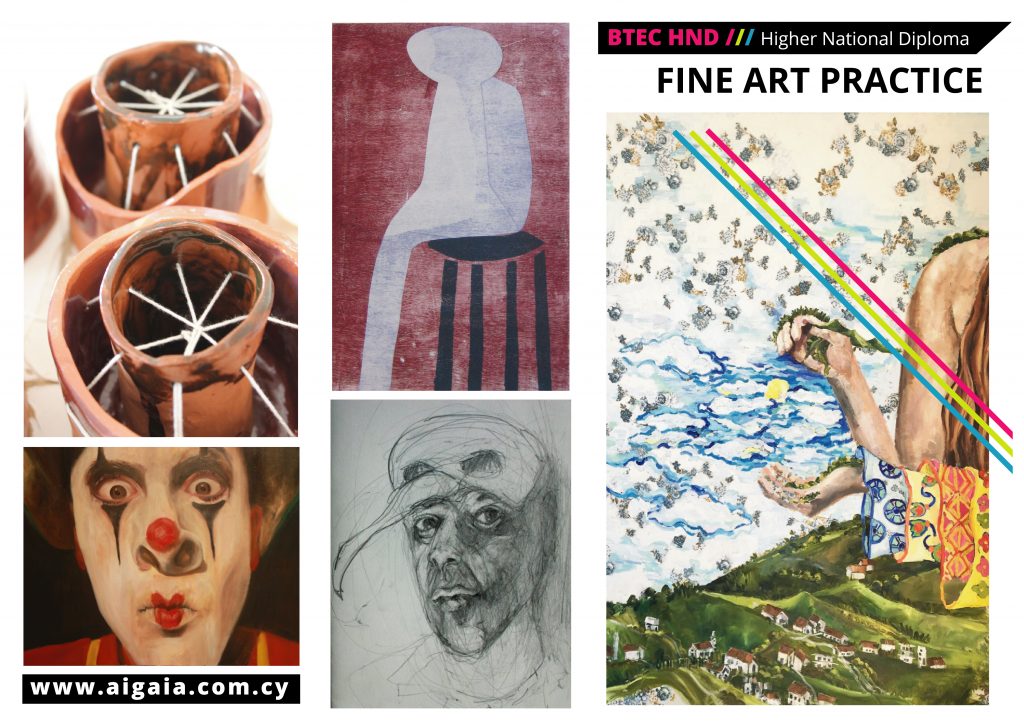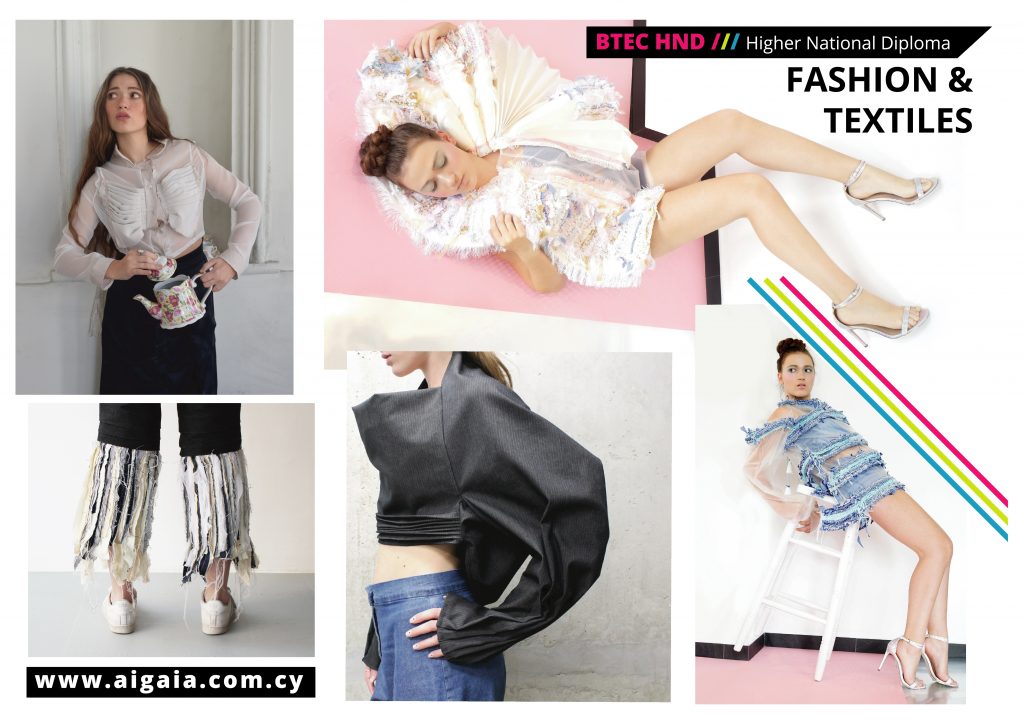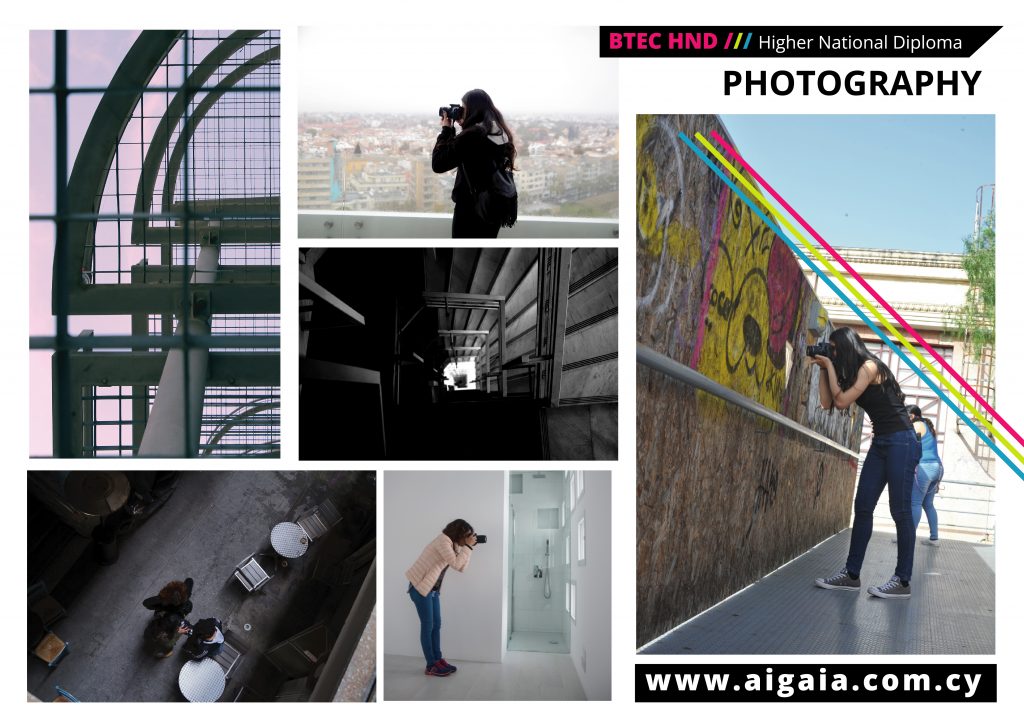BTEC Higher National Diploma
HND in Fine Art
HND in Fashion & Textiles
HND in Photography
HND in Product Design
HND in Graphic Design
An offer for a place to the Higher National Diploma is mostly depended on the student’s previous relevant education and experience, including the student’s portfolio.
How long does it take to complete?:
Full time: 2 or 3 years
Part time: This is flexible, usually students will study for as long as it will take for each individual case to complete the course, according to the time they spend on it.
After the successful completion of the Higher National Diploma (HND) at Aigaia School of Art & Design in any specialisation and after evaluation of their portfolio as the main criterion, students will be able to continue their studies on the final year of a degree in Universities in the UK.
Who is the programme for?:
The HND has been designed to equip students with the knowledge, understanding and skills required for success in current and future employment or for progression to the 3rd year of an undergraduate degree course at a UK University. Some learners may wish to make the commitment within their specialised area of study and become professional artists.
What can I do next?:
The majority of students continue to practice as artists – a high proportion will be successful in gaining entry to top up BA (Hons) at UK Universities. Some students will find work in related areas including curating, gallery management, working as stylists and photographers in magazines, teaching, or work freelance in all three specialisations of the Higher National Diploma courses. Other students will have developed their creative skills in associated areas such as crafts, textile design, ceramics, illustration, set design, digital media/photography and so on.
How is the programme assessed?:
A range of assessment methods will be used, including presentations of visual work, essays and submission of completed projects. Continual assessment will always take place including seminar presentations, group critiques and workshops. More formal assessment takes place at the end of each semester. Summative assessment takes place at the end of the year. At assessment students present their work – practical, written and digital. They will receive verbal and written feedback. Personal tutorials are very important throughout the year in which structured feedback and critical appraisal will be given. Students will be graded for the units covered in each project, which provides a continuing log of progress.

context of the course:
This creative course combines both traditional and contemporary approaches to fine art with an emphasis on the multidimensional approach, on which if desired students can work through a range of different media and approaches. Students will explore Fine Art practice through a variety of assignments, site-specific location projects, work-based experience, lectures, opportunities for showing and exhibiting own work. These assignments encourage a professional approach and explore a wide range of visual language across both 2D and 3D specialist areas.
Subjects include: • Fine Art Painting• Fine Art Printmaking • Fine Art Ceramics• Installation and Performance in Fine Art • Photography • Digital Media in Art & design • Animation techniques •Drawing in Fine Art • Site-Specific Fine Art• Visual and personal presentation• Critical Studies in Fine Art• Lens-based Recording Techniques• Development of a Fine Art Identity and Language• Exhibition of Artwork•
Within the context of the course, the students will be taught of the importance of research, how to produce and invent ideas and how to develop and express their personal visions, through a multidimensional approach to Fine Art. They will experiment with ideas and products such as images, objects, and techniques.
Once the students manage to distinguish, understand and realize all that are involved in Fine Art, the aim then would be to experiment with specific procedures and materials in order to understand their own personal visual language. Through studio-based learning, which is the most efficient art and design teaching method, students will develop their skills and their ability to research, experiment and generate creative ideas and results. The development of the students will be on going throughout the two years of the course and the teaching will be continuous and focused on the individual needs.
By the end of the 2 years students will have knowledge and understanding of:
• Contexts and issues relating to the professional practice of Fine Art.
• A range of skills and techniques, personal qualities and attitudes essential for successful performance in professional working life regarding the fine art specialisation.
• Personal work through knowledge and guidance in the areas of: Drawing, Printmaking, Fine Art Photography, Installation and Performance and digital images.
• Their own personal Fine Art language through the development of their own Artwork.
• Traditional and contemporary theories and practices in: Drawing, Printmaking, Fine Art Photography, Installation and Performance and digital images.
• Essential facts, concepts, principles and theories in Professional Practice relating to Fine Art appropriate to the Creative industries.
• Traditional and Contemporary techniques in Fine Art and professional Practice.
• The expressive potential in Fine Art practices.
• Artist’s relationship with audiences, clients and markets.
• How to exhibit the Artwork in a professional and sophisticated manner.
• Effective self-promotion appropriate to the needs of the Creative Industries.

HND in Fashion & Textiles is an exciting programme of specialist vocational learning, which reflects the requirement of professional organisations and meets the National Occupational Standards for each sector or industry. With their strong emphasis on developing practical skills alongside specialist knowledge and understanding for the sector, HND in Fashion & Textiles is recognised internationally by employers as providing learners with the key concepts and practical skills for direct progression to – or within – employment. Learners have the opportunity to master the essential techniques of their craft and develop their higher-level skills in Fashion and Textiles. The skills for success: broaden students’ experience and depth of knowledge, allowing them to develop a range of skills, techniques and attributes essential for successful performance in working life.
Fashion design:
The students through a structured course of workshops have the opportunity to develop an understanding of taking 2D design into 3D design and to experiment with creative pattern design and to work on the stand (draping/toiling), cutting for different silhouettes, to develop their pattern cutting skills, measuring and fitting as well as to be introduced to the various sewing techniques so to perfect their sewing abilities. Also to understand the body, when it comes to drawing it and developing their own fashion illustrations. All these skills are developed in order for the student to have the necessary technical background in order to define their work from a personal perspective as future professionals or if they chose to continue their studies in a university degree level.
From Ready to Wear (Prêt-à-Porter) and Made to Measure to Avant-Garde and High Fashion (Haute Couture), students will explore design concepts across a range of seasons and product areas, using research, design and presentation skills. This will give them the opportunity to explore various terms with focus on the importance of innovative cut to fabric and the design process, what constitutes a range or collection, and design in relation to a chosen consumer/market. They will also deal with Contemporary Issues in Research and they will be provided with a broad overview of some of the different critical and methodological approaches to researching in art and design culture.
Textiles design & art:
With emphasis on teaching technical and practical nature of the course, the general objective of this course is to equip students with practical skills, which can be applied in a more artistic work or in more industry based project. Giving students another means of creating, allows them to expand further their artistic language and implement creative results. Students will be taught specialised professional techniques used in todays creative textile industries and also will be introduced to various traditional techniques such as: sewing, hand stitching, embroidery, beading, appliqué, patchwork, quilting, crochet, knitting, weaving, fabric painting and printing with screen printing, dying: batique, tie-dye, etc. and mixed techniques.
Learning environment:
The practices and techniques taught and applied within a visual framework will give a new dynamic to their aesthetics and in the process of creating, opening new doors to exploration, experimentation and implementation to create various artistic effects. The aims of the course are for the students to broaden their practical skills and apply the techniques taught as future professionals or if they chose to continue their studies in a university degree level.
The studio:
The fashion and textiles facility aims to provide the students with the experience of a professional studio in terms of equipment and operation. It is equipped with industrial sawing machines, industrial over locker, weaving machine, a professional workstation, tailor’s dummies, garment rails and is well equipped with all tools and resources necessary for textiles design and fashion design and making. Students will be trained to operate all the machines concerning their specialization, in order to be prepared for their future as professionals in fashion and textiles design, as well as for further studies.

The Higher National Diploma in Photography at Aigaia School of Art and Design have been developed to focus on:
• Educating and training the students for a range of careers in photography.
• Providing opportunities for students to gain a specific qualification that will enable them to enter employment in photography if they wish or progress to a full-time degree in photography or related areas.
• Developing the students’ knowledge, understanding and skills in the field of photography.
• Providing opportunities for developing a range of skills and techniques and attributes essential for successful performance in working life.
• Developing learners’ critical awareness and their ability to research and synthesise complex information regarding the specific specialisation.
• Developing students skills in communication and presentation their work and ideas.
Over the course of study, students are expected to concentrate on a number of different elements of photography. Some of these include: studio photography, location photography, photojournalism, digital postproduction, creative image production and manipulation, how photography can become an artwork, its relation to other disciplines of art & design. The broad variety of available units will help you discover which area of photography you are particularly passionate about.
The objectives of the Pearson BTEC Higher Nationals in Product Design are to:
• Developing the students’ knowledge, understanding and skills in the field of photography.
• give students the skills, knowledge and understanding they need to achieve high performance in the international product design environment
• develop students with enquiring minds, who have the abilities and confidence to work across different business functions and to lead, manage, respond to change, and tackle a range of complex product design situations
• provide the core skills required for a range of careers in product design, specifically those related to management and operations
• offer a balance between employability skills and the knowledge essential for students with entrepreneurial, employment or academic ambitions
• develop students’ understanding of the major impact that new digital technologies have on the product design environment
• provide insight into international business operations and the opportunities and challenges presented by a global marketplace
• equip students with knowledge and understanding of culturally diverse organisations, cross-cultural issues, diversity and values, and to allow flexible study to meet local and specialist needs.
The objectives of the Pearson BTEC Higher Nationals in Graphic Design to:
• give students the skills, knowledge and understanding they need to achieve high performance in the international graphic design environment
• develop students with enquiring minds, who have the abilities and confidence to work across different business functions and to lead, manage, respond to change, and tackle a range of complex graphic design situations
• provide the core skills required for a range of careers in graphic design, specifically those related to management and operations
• offer a balance between employability skills and the knowledge essential for students with entrepreneurial, employment or academic ambitions
• develop students’ understanding of the major impact that new digital technologies have on the graphic design environment
• provide insight into international business operations and the opportunities and challenges presented by a global marketplace
• equip students with knowledge and understanding of culturally diverse organisations, cross-cultural issues, diversity and values, and to allow flexible study to meet local and specialist needs.
